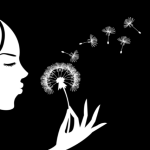
“The main affliction of our modern civilization is that we don’t know how to handle the suffering inside us and we try to cover it up with all kinds of consumption.” ~Thich Nhat Hạnh
Since I was little, I’ve been taught to avoid what’s “bad” and move toward what’s “good.”
Growing up, my mom would work day and night not only to support me and my little brother with the basic necessities, but to give us a “good” life.
She loved us, so naturally she wanted to support us and to give us happiness, and she was obsessed with the idea that if she grew her business we would all have just that.
She went from selling clothing she sewed in our home to interested buyers to moving millions of dollars of merchandise, made by teams of sewers, to other companies who sold it for her.
Everything was in an effort to help keep us away from the “bad” and give us the “good.” If anything, she taught us that money was definitely a primary focus (or so I thought).
I learned to draw a clear distinction between good and bad, and that I’m supposed to react a very specific way toward one (sadness, anger, fear toward those things I didn’t want—the bad) and a very specific way toward the other (joy, happiness, feelings of peace toward those things I did want—the good).
I lived so much of my life trying to minimize, even eliminate, the bad and amplify the good as high as it would go, following the example that was set for me.
But I didn’t get anywhere.
At certain points, things looked better for a time, but then something would happen and mess it all up. At that point, I was left with no energy to continue and wondering if it was even worth it to try.
Oddly enough, we can have some of our most peaceful moments when we give up all efforts at trying to find or acquire happiness.
Up until now, I’ve been talking about myself. But this isn’t just about me, is it? No, this is our story—all of ours.
We’ve all been taught to avoid the bad and do whatever we can to attract, or move toward, the good.
We’ve also been taught to react negatively to those perceived “bad” things and positively to those perceived “good” things.
The thing is, good and bad are concepts created in our mind; they’re not reality.
To divide reality in this way is what’s called “duality,” and it’s the misconception that there’s this imaginary separation between things that really doesn’t exist.
It’s harmful to live by duality, to imagine that the sorrow we feel when a loved one dies and the joy we get when we smell a flower are separate and unrelated things.
There’s a saying that goes, “Without the mud, there can be no lotus.”
What this means is that without our suffering, without the difficulties and challenges we’re faced with, we literally wouldn’t have the capability to experience peace and joy.
Our pain and suffering is the very soil within which the flower of our true potential can grow.
Five years ago I was filled with stress, anxiety, and fear.
My first son was to be born in a matter of months, and I had no idea how I was going to support my family. I could barely pay my bills, let alone be an example for my son, having still not accomplished anything of value in my life.
But by accepting my challenges fully and openly, with love and compassion, I became liberated. My mind became clear and my challenges became fuel for the fire of my love to burn and become bright.
What initially seemed like a great challenge turned into my greatest source of motivation, the motivation to get out there and do something my son would be proud of. And in that moment, my challenges were transformed into great sources of peace and joy. The bad became the good.
It’s because of the sorrow, the anger, the fear, and the regret, frustration, and stress we feel that we’re able to experience the joys that life has to offer.
Pain and suffering and peace and happiness are literally one and the same, more of a spectrum than two separate and unrelated things. Without one, we wouldn’t have the other. Knowing this, you must learn how to accept your pain and suffering and transform it.
We’re the lotus bud waiting to awaken to our true potential. If we can learn to accept our mud (our pain and suffering) openly, honestly, and compassionately, we can transform our very relationship with it and realize greater peace and joy.
Sometimes, we do things we regret. Sometimes, people do things to us. And sometimes, things happen that will effect us for years to come, or our entire lives.
No matter how you suffer, no matter what type of pain you feel, accepting it as the bed in which you will grow is a liberating shift in how you see the world.
Many times, simply making the conscious decision, “I accept this suffering,” instead of running from it or trying to push it away as we’ve been taught to do, can bring us much peace and joy.
This isn’t about some special technique or practice; it’s simply about that mental shift—making the decision in your mind to honestly and compassionately accept everything that comes your way, good or bad.
You can use this simple mantra to empower you during tough times and to remind you to accept your pain and suffering with open arms:
I see you here ______ (fear, anger, sorrow, stress). My arms are open wide. I accept you fully, with love and compassion.
It’s with this pain and suffering that you’ll blossom into a beautiful lotus.
Accept these challenges as opportunities for growth and you’ll realize the true peace, joy, and freedom that exists beyond the concept of “good” and “bad.” “Good” things happen when you stop resisting the “bad” and instead allow it to transform you.
Man in field image via Shutterstock
About Matt Valentine
Matt Valentine is a father, husband, and a self-published author. He writes weekly on his blog, Buddhaimonia.com, about everything from spirituality to self-mastery. You can get his eBook, The Little Book of Mindfulness, free by joining his newsletter here.













 Though I run this site, it is not mine. It's ours. It's not about me. It's about us. Your stories and your wisdom are just as meaningful as mine.
Though I run this site, it is not mine. It's ours. It's not about me. It's about us. Your stories and your wisdom are just as meaningful as mine.